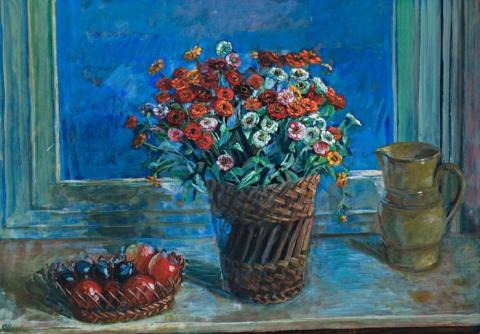ZINNIAS AND FRUIT, c.1973
Margaret Olley
oil on composition board
72.5 x 103.5 cm
signed lower left: Olley
Holdsworth Galleries, Sydney (label attached verso)
Von Bertouch Galleries, Newcastle (label attached verso)
Sotheby's, Melbourne, 30 April 2002, lot 46
Private collection, Sydney
Zinnias and Fruit is special among Margaret Olley's still life paintings for its extensive use of blues, providing an effective contrast to the reds of the flowers and apples. Olley's paintings, celebrated for their rich colours, usually enjoy a predominance of browns and reds, expressing the warmth of the artist's personality and her conviviality. Cedar furniture in its natural state, or a brightly patterned kilim often provide the keys to the moods of her paintings, the lively strokes of her brush giving her works a particular vivacity. The colour blue in Zinnias and Fruit, strikes a different note, more given to a nocturne or a serenade than the scherzo mood of so many of her works. The blue background of the window suggests night, giving an overall mood of peace and quietude. There is no view through to the garden or landscape beyond, another feature of many of her paintings. Instead, by reducing pictorial depth to the minimum, she focuses attention on the foreground, the very objects of the still life. Individual to this painting, the gentlest light falls from the upper right, casting the lightest of shadows. Her objects perform rather like actors on a stage, brought forward to its edge and their appreciative audience. A similar example is the splendid Ranunculus and Fruits I, 1973 in which her cast of fruit, flowers, jugs and vases provide bright highlights against the deep blue backdrop.1 The pictorial device of the dark window is used to great effect in several other comparable paintings such as Evening Still Life, c.1976 and White Still Life, 1977.2
Olley once said, 'I never arrange things. I just put them down and don't move them.'3 This is apparent in the informality of the composition of Zinnias and Fruit. It is Olley's ability to convert the everyday and her matter-of-fact approach into works of creative pleasure that marks her out as an artist for particular attention. Speaking of objects of her delight, Olley observed, 'I can feel for flowers as I can for people. Painting flowers is almost like painting a portrait.'4 Interiors and still life paintings filled with the light of early morning or afternoon are typical. It is the more diffused evening light that is uncommon and thereby such paintings are all the more special in her art.
1. Private collection, see Pearce, B, Margaret Olley, Art Gallery of New South Wales, Sydney, 1997, pl. 32 (illus.)
2. ibid., pls. 37 & 43 (illus.)
3. ibid., p. 81
4. ibid., p. 76
DAVID THOMAS
